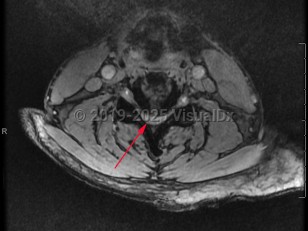Cervical spinal stenosis
Alerts and Notices
Important News & Links
Synopsis
Cervical spinal stenosis is the narrowing of the spinal canal in the neck. Asymptomatic spinal stenosis may be discovered incidentally on imaging, but when it causes impingement of the spinal cord or nerve roots, symptoms can include weakness of the extremities, numbness / paresthesias, and neuropathic / radicular pain.
Narrowing of the cervical spinal canal can result in myelopathy that will result in upper motor neuron signs, such as hyperreflexia, especially in the lower extremities. Patient may experience walking difficulties or ataxia. Neck pain is common. Narrowing of the neural foramina in the cervical spine will often cause a radiculopathy. Compression of the cervical nerve roots can result in lower motor neuron signs in the upper extremities, which may result in muscle atrophy and fasciculations. Symptoms typically worsen with extension of the spine and improve with flexion.
Spinal stenosis can be congenital, but more typically it is acquired. It most frequently presents in the sixth decade of life or later due to degenerative changes to the spine that result in progressive narrowing of the spinal canal and/or neural foramina. It is also possible that people with congenitally narrow spinal canals are more likely to experience symptoms during the process of aging. Other risk factors for the development of spinal stenosis include inflammatory arthropathies such as rheumatoid arthritis, traumatic injuries, and neoplastic disease.
Related topic: Lumbar spinal stenosis
Narrowing of the cervical spinal canal can result in myelopathy that will result in upper motor neuron signs, such as hyperreflexia, especially in the lower extremities. Patient may experience walking difficulties or ataxia. Neck pain is common. Narrowing of the neural foramina in the cervical spine will often cause a radiculopathy. Compression of the cervical nerve roots can result in lower motor neuron signs in the upper extremities, which may result in muscle atrophy and fasciculations. Symptoms typically worsen with extension of the spine and improve with flexion.
Spinal stenosis can be congenital, but more typically it is acquired. It most frequently presents in the sixth decade of life or later due to degenerative changes to the spine that result in progressive narrowing of the spinal canal and/or neural foramina. It is also possible that people with congenitally narrow spinal canals are more likely to experience symptoms during the process of aging. Other risk factors for the development of spinal stenosis include inflammatory arthropathies such as rheumatoid arthritis, traumatic injuries, and neoplastic disease.
Related topic: Lumbar spinal stenosis
Codes
ICD10CM:
M48.02 – Spinal stenosis, cervical region
SNOMEDCT:
83561009 – Spinal stenosis in cervical region
M48.02 – Spinal stenosis, cervical region
SNOMEDCT:
83561009 – Spinal stenosis in cervical region
Look For
Subscription Required
Diagnostic Pearls
Subscription Required
Differential Diagnosis & Pitfalls

To perform a comparison, select diagnoses from the classic differential
Subscription Required
Best Tests
Subscription Required
Management Pearls
Subscription Required
Therapy
Subscription Required
References
Subscription Required
Last Reviewed:08/28/2018
Last Updated:09/11/2018
Last Updated:09/11/2018
Cervical spinal stenosis

